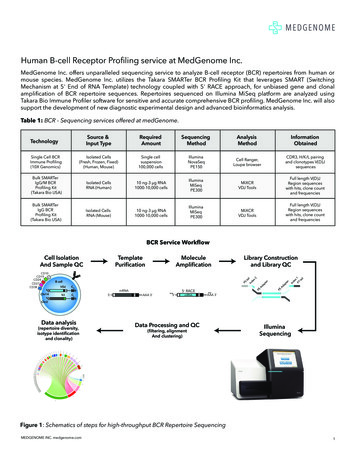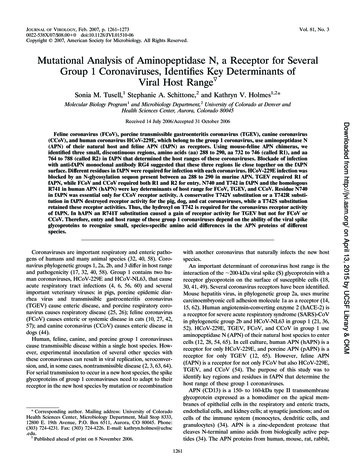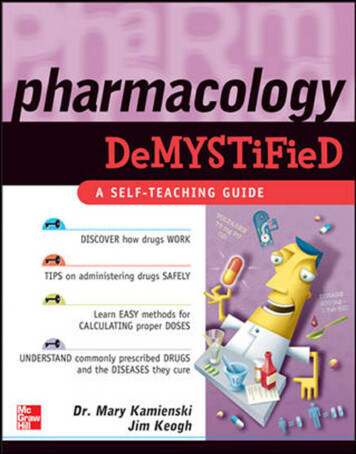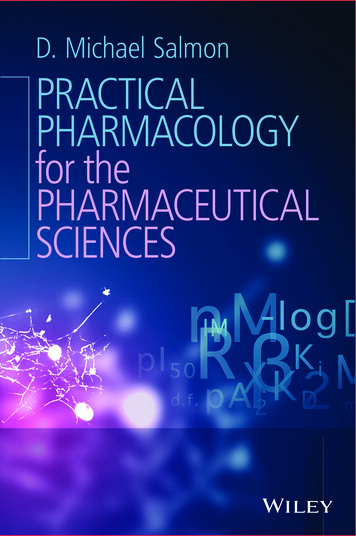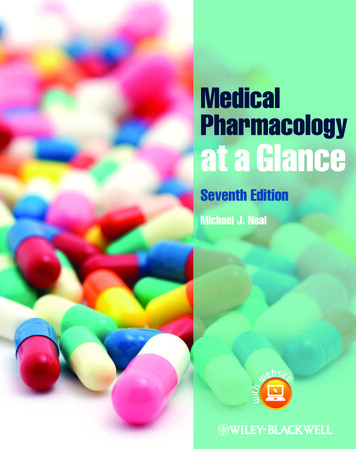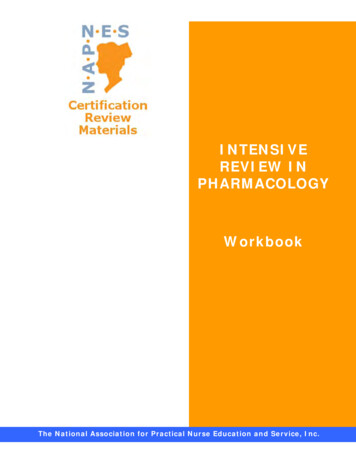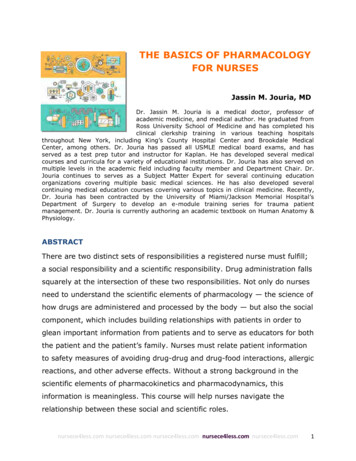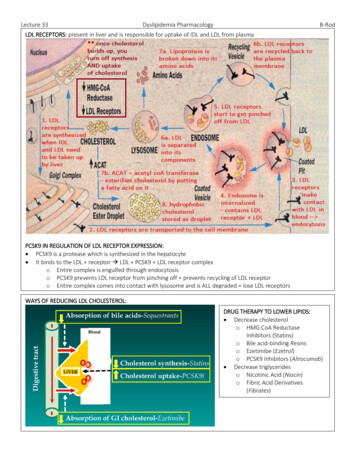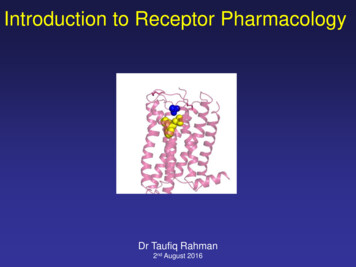
Transcription
Introduction to Receptor PharmacologyDr Taufiq Rahman2nd August 2016
Part I:A general overview of receptors
what is sustaining life?how a cell biologist will look at this?
sustaining life means that cells are‘alive & kicking’ properlyexternal world(continually changing,full of pleasant &unpleasant surprisescells, though insulatedby a membrane, needto adapt to thesechangesit is absolutely critical that these external changes arerecognized properly and on time
sustaining life then becomes.receiving the externalchanges (recognition)interpretation of themessages(decoding)execution of appropriateresponsesthis is crucial for maintaining the normalcy within(homeostasis)
cells have receptors to ‘receive’ and‘process’ the extracellular informationexternal messages(often cell impenetrable)Rtransductiondecodingappropriate response(s)receptors ensure that cells always know what theyare, where they are, and what they should be doing
what are receptors these are specialized, membrane-bound proteins they receive (bind to) external stimuli upon receiving external signal, they undergostructural changes this ultimate trigger various cellular activities thus they effectively serve as signal transducer
receptors are primitive means for cellsurvivalpheromone signalling of haploid Yeast(Saccharomyces cerevisiae)when a haploid individual is ready to mate, itsecretes a peptide mating factor that signals cellsof the opposite mating type to stop proliferating andprepare to mate
receptors are primitive means forsurvivalslime mold (Dictyostelium discoideum)once the supply of food is exhausted, individual amoebae begin to move together( 1mm/hr) – triggered by cAMP released from starving ones!
receptors’ role as readers are criticalproblem occurs.failure in readingreading too muchreading the wrong message
what do receptors read – the firstmessengerEssential Cell Biology ( Garland Science 2010)
common first messengers for receptors Amino acids and their derivatives – glutamate, GABA, glycine Proteins & peptides (various hormones, growth factors) Nucleotides – ATP, ADP, AMP Small inorganic ion (eg. Ca2 ) derivatives of fatty acids steroids retinoids gases (NO, H2S) physical stimuli (heat, cold, touch, smell, light etc.) and most of the drug moleculesif any of the above (most actually do) physically binds to areceptor, it is called a ‘ligand’
delivering the signal to its receptorfirst messengers operate over various distances
delivering the signal to its receptorintracrineautocrineself-stimulating processcan be problematic (cancer)
major types of receptors
how prompt our receptor need to be? VERY FAST (milliseconds)nerve conduction, vision- ion channels FAST (seconds)vision, metabolism, cardiovascular activities- G protein-coupled receptors SLOW (minutes to hours)cell division, proliferation, developmentalprocesses- growth factor receptors-steroid hormone receptors
receptor activation often produces 2ndmessengers
some common 2nd messengers soluble second messengerscyclic ADP ribose(cADPR) membrane bound second messengersPIP3arachidonic acidceramide
what dictates the cellular activity(specially when it never receives single stimulus)each cell expresses a cohort ofreceptors & other signallingproteins that eventually govern itsresponses to different stimuliwithout confusing
nature of response depends ontypes of receptors
nature of response depends ontypes of receptors
quiz: histamine neNHN NOClH1allergic reactionH2gastric acid secretionO
end of part I
part II:receptor-ligand interaction
receptor-ligand interactionreceptors are presentin the plasma membraneas well as inside the cells.
receptor-ligandinteraction A ligand interacts with a bindingsite on the receptor ligand binding triggers alocal conformational change conformational change ispropagated via the membranespanning helices conformational changes occuron the intracellular face of thereceptor that initiates cellularresponse
introduction of the ‘receptor’ concept
recognition of the ligand at its receptor siteLock and key theory(Fischer, 1890)induced fit theory(Koshland 1958)‘’To use a picture, I wouldlike to say that enzymeand glucoside have to fitto each other like a lockand key in order to exert achemical effect on eachother.”
recognition of the ligand at itsreceptor sitevarious types of forces are typically involved
molecular recognition of the ligand‘together we bind’multiple but individually weak forces make surethat a functionally viable but reversibleligand-receptor complex is formed.
recognition of the ligand at itsreceptor siteAn enzyme (COX-2) bound to a painkiller (Flurbiprofen)
techniques to measure ligand-receptorinteractionLigand binding assays address the first step of ligandreceptor interaction – the physicochemical propertiesand kinetics of ligand-receptor complex formationFunctional assays measure the actual biologicalresponse (electrical or biochemical or physical)evoked by the ligand via its receptor
10050Kd% max. response% receptor bindingquantification of ligand-receptor quiz: why do the curves plateau?potency
quantification of ligand-receptor interactionbiological response receptor occupancy[Rbound][RTotal]responseA. J. Clark(1937)log [L]max. response (%)Occupancy theory: EC50 KDreceptor occupancy (%)
quantification of ligand-receptor interactionmodification of the occupancy theoryoccupancy 1% of histaminereceptors was adequate toproduce maximum effectNickerson (1956); Naturetissues tend to have ‘spare receptors’EC50 values are typically Kd
what allows EC50 Kd:signal amplification
% max. responseligand conc. – biologic response relationship10050EC50% max. response[ligand]EC50log [ligand]
quantification of ligand-receptor interactionmodification of the occupancy theoryoccupancy theory: EC50 KD[bound receptors] magnitude of responseoccupancy [total receptors]But some ligands fail to produce maximum response evenat very high concentrationsAriens (1954) & Stephenson (1956)magnitude of response A . fractional occupancyefficacy or intrinsic activity
ligand-receptor interaction:affinity vs efficacy affinity: ability to bind efficacy: ability to activate antagonists have same (orhigher) affinity but no efficacy partial agonists havelower efficacy
what underlie the differences betweenaffinity and efficacyb-adrenergic receptor(b-AR)certain contacts can be crucial foractivitybAR blocker
various forms of receptor antagonismreceptor can be reversibly or irreversibly inhibited
various forms of receptor modulation
end of part II
Part III:common receptor classesterminating active receptors
major types of receptors
heterotrimeric G proteins act astransducers for GPCRsstimulirecognition &receptionGPCRsignaltransductioneffector moleculesenzymesexecution ofresponses ion channelscellulareffects
diversity of GPCRs
GPCR signalling shapes organismresponse‘fight or flight’ responsesympathetic nervous systemAdrenalin/noradrenalin mediatedvia a-AR and b-AR‘rest & digest’ response’parasympathetic nervous systemacetylcholine mediatedvia muscarinic and nicotinic AChR
some GPCRs signal by regulating the productionof cyclic AMP
some GPCRs activate the inositolphospholipid signalling pathway
termination ofGPCR signaling(routes fordesensitization)
classical model of GPCR signalling signalling is mediated by Ga and bg only b-Arrestin is only involved for receptordesensitization and internalisationcurrent view of GPCR signalling signalling is mediated by Ga and bgas well as by b-Arrestin b-Arrestin also mediates receptordesensitization and internalisation
biased agonism or stimulus traffickingoriginal notionLigands that bind GPCR have unbiasedpreference towards G protein and b-arrestinmediated downstream signalling pathwaysi.e. they signal equally through bothcurrent viewLigands that bind GPCR may selectivelypromote either G protein or b-arrestinmediated downstream signalling pathways
ion channels – receptors with holes integral membrane proteins contain ion conductive pores allow influx or efflux of ions across biological membranes can be activatedby changes in membrane potentialbinding of particular ligandschanges in pH, temperature, cell volumechanges in intracellular Ca2 concentrationmechanical deformation or stress
major types of ion channels voltage-gated ligand-gated gap junctions others e.g. mechanosensitive
receptors with enzyme activitygrowth factor receptorsthe substrate protein can be an enzyme or an adaptor protein
intracellular receptorsnuclear hormone receptorsintracellular ionotropicreceptors (ion lasm
A very good and up to dateresource on receptors & /csb/If interested, may also consider visiting :http://www.guidetopharmacology.org/
THANKS
Introduction to Receptor Pharmacology Dr Taufiq Rahman 2nd August 2016. Part I: A general overview of receptors. what is sustaining life? how a cell biologist will look at this? sustaining life means that cells are ‘alive & kicking’ properly external world (continually changing, full of pleasant & unpleasant surprises cells, though insulated by a membrane, need to adapt to these changes it .
